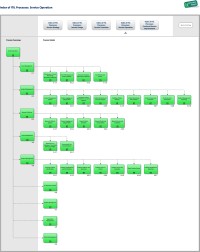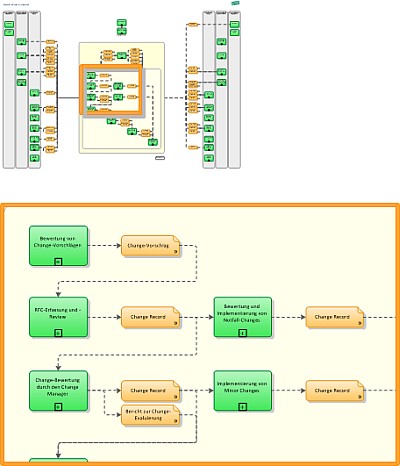ITIL Implementation - Process Structure: Difference between revisions
No edit summary |
mNo edit summary |
||
| Line 1: | Line 1: | ||
<seo metakeywords="itil process structure, itil structure, it process structure" metadescription="Definition of the To-Be Process Structure - Fig. 1: Selection of Relevant ITIL Processes from the Reference Process Structure." /> | |||
<imagemap> | |||
Image:ITIL-Wiki-de-es.jpg|DE - ES - ITIL To-Be Process Structure|100px | |||
rect 0 0 50 30 [https://wiki.de.it-processmaps.com/index.php/ITIL-Implementierung_-_Prozess-Struktur diese Seite auf Deutsch] | |||
rect 50 0 100 30 [https://wiki.es.it-processmaps.com/index.php/Implementaci%C3%B3n_de_ITIL_-_Definici%C3%B3n_de_la_estructura_de_procesos esta página en español] | |||
desc none | |||
</imagemap> | |||
<br style="clear:both;"/> | |||
{| | {| | ||
|- | |||
| style="border-bottom:1px solid grey;" |<big><strong> Step 5: Definition of the To-Be Process Structure </strong></big> | |||
|} | |} | ||
==== Description ==== | |||
The to-be process structure does not contain detailed process descriptions - these are developed at a later stage | [[image:Thumb_to_be_process_structure.jpg|frame|right|Figure 1: Selection of Relevant ITIL Processes from the Reference Process Structure]] | ||
Following the analysis of the initial situation, it can be decided in more detail where the ITIL project will put its focus. In practice this means to determine which ITIL processes are to be introduced, resulting in in a structured process breakdown. | |||
The [[ITIL Processes|ITIL processes]] to be introduced often result in a direct way from the project objectives: | |||
If the project serves the objective of enhancing user support, The "[[Incident Management|Incident Management]]" process is to be established or improved. Because of their close links with Incident Management, the "[[Problem Management|Problem Management]]" and "[[Service Asset and Configuration Management|Service Asset and Configuration Management]]" processes should also be included in the project scope. | |||
The aim of this project step is primarily to choose the ITIL processes and sub-processes. The to-be process structure does not contain detailed process descriptions - these are developed at a later stage. | |||
ITIL process templates (e.g. the [https://en.it-processmaps.com/products/itil-process-map.html ITIL Process Map V3]) can be used to support this step because they contain a generic process structure. | |||
==== Objective of this Project Step ==== | ==== Objective of this Project Step ==== | ||
| Line 17: | Line 34: | ||
==== Prerequisites ==== | ==== Prerequisites ==== | ||
* Results of the ITIL assessment | * Results of the [[ITIL Implementation - ITIL Assessment|as-is process assessment]] | ||
* Project objectives („What is | * Project objectives („What is the motivation for introducing ITIL Best Practice?”). | ||
==== Results/ Deliverables ==== | ==== Results/ Deliverables ==== | ||
* | * Structured breakdown of the ITIL processes to be introduced | ||
* | |||
[[image: | ==== Success Factors ==== | ||
< | |||
==== | * The definition of the process structure should not try to anticipate later project steps; the aim of this step is to identify the processes and sub-processes to be introduced, not to specify processes in great detail. | ||
[[image:thumb-itil-process-overview.jpg|frame|right|Figure 2: Overview diagram, depicting ITIL process interdependencies]] | |||
==== <span style="color:#5d5d5d">Relevant Views of the ITIL Process Map V3</span>==== | |||
<span style="color:#5d5d5d">The [https://en.it-processmaps.com/products/itil-process-map.html ITIL Process Map V3] contains a complete ITIL-compliant process structure, arranged in a hierarchical way (see Figure 1). This generic process structure can be used in many cases with only minor changes.</span> | |||
<span style="color:#5d5d5d">Process overviews (see Figure 2) depict the process interdependencies and help to choose an adequate to-be process structure.</span> | |||
'''Following Project Activity''': | |||
→ ITIL Implementation - Step 6: '''[[ITIL Implementation - Process Interfaces|Definition of Process Interfaces]]''' | |||
= | <br style="clear:both;"/> | ||
<!-- This page is assigned to the following categories: --> | |||
[[Category:ITIL V3]][[Category:ITIL implementation]] | |||
<!-- --- --> | |||
Revision as of 20:29, 26 July 2011
<seo metakeywords="itil process structure, itil structure, it process structure" metadescription="Definition of the To-Be Process Structure - Fig. 1: Selection of Relevant ITIL Processes from the Reference Process Structure." />

| Step 5: Definition of the To-Be Process Structure |
Description

Following the analysis of the initial situation, it can be decided in more detail where the ITIL project will put its focus. In practice this means to determine which ITIL processes are to be introduced, resulting in in a structured process breakdown.
The ITIL processes to be introduced often result in a direct way from the project objectives:
If the project serves the objective of enhancing user support, The "Incident Management" process is to be established or improved. Because of their close links with Incident Management, the "Problem Management" and "Service Asset and Configuration Management" processes should also be included in the project scope.
The aim of this project step is primarily to choose the ITIL processes and sub-processes. The to-be process structure does not contain detailed process descriptions - these are developed at a later stage.
ITIL process templates (e.g. the ITIL Process Map V3) can be used to support this step because they contain a generic process structure.
Objective of this Project Step
- Determination of the Service Management processes which are to be introduced
- Breakdown of processes into sub-processes
Prerequisites
- Results of the as-is process assessment
- Project objectives („What is the motivation for introducing ITIL Best Practice?”).
Results/ Deliverables
- Structured breakdown of the ITIL processes to be introduced
Success Factors
- The definition of the process structure should not try to anticipate later project steps; the aim of this step is to identify the processes and sub-processes to be introduced, not to specify processes in great detail.

Relevant Views of the ITIL Process Map V3
The ITIL Process Map V3 contains a complete ITIL-compliant process structure, arranged in a hierarchical way (see Figure 1). This generic process structure can be used in many cases with only minor changes.
Process overviews (see Figure 2) depict the process interdependencies and help to choose an adequate to-be process structure.
Following Project Activity:
→ ITIL Implementation - Step 6: Definition of Process Interfaces






